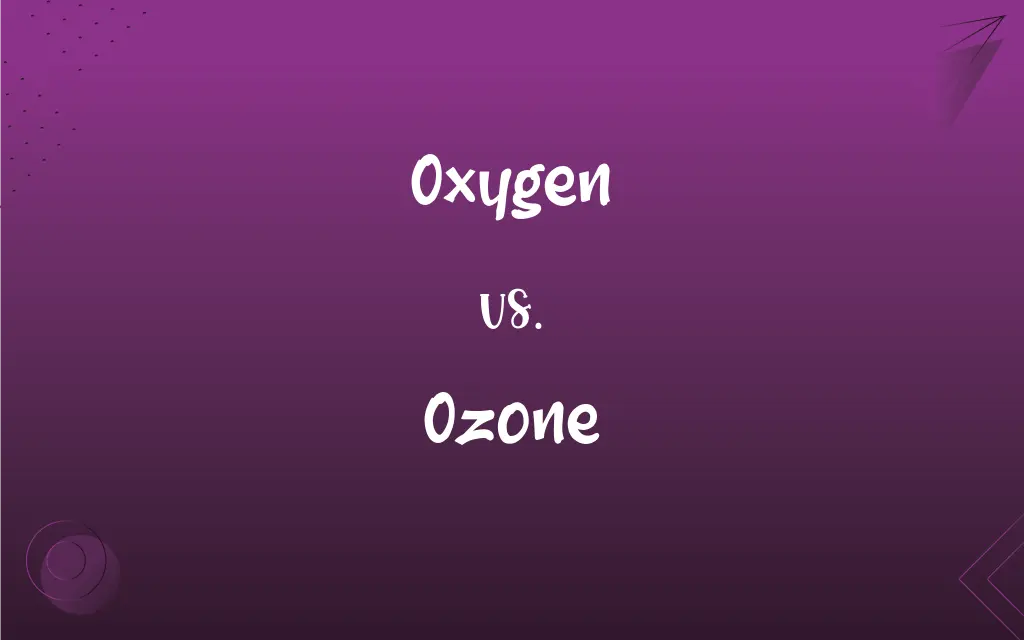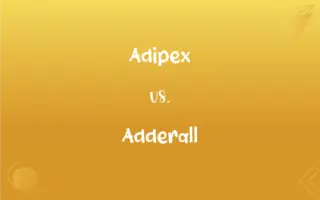Oxygen vs. Ozone: What's the Difference?
Edited by Aimie Carlson || By Harlon Moss || Published on February 17, 2024
Oxygen is a diatomic molecule (O2), essential for respiration, while ozone is a triatomic molecule (O3), known for its role in the Earth's stratosphere.

Key Differences
Oxygen (O2) is a colorless, odorless gas at room temperature, essential for human respiration and combustion. Ozone (O3), on the other hand, is a form of oxygen with three atoms per molecule and is less stable than O2.
Oxygen is vital for life; it's used in cellular respiration by most organisms. Ozone, while also a form of oxygen, is not used for respiration and is known for its strong, pungent odor.
In the Earth's atmosphere, oxygen is found in the troposphere and is crucial for sustaining life. Ozone is mainly found in the stratosphere, where it forms the ozone layer, absorbing and protecting us from the sun's harmful ultraviolet rays.
Oxygen is used in various industries, including healthcare (for medical purposes) and manufacturing. Ozone has different applications, such as in water purification processes and as a disinfectant because of its oxidative properties.
Exposure to high concentrations of oxygen can be harmful, potentially leading to oxygen toxicity. Ozone, even in small amounts, can be harmful to the respiratory system and is considered a pollutant at ground level.
ADVERTISEMENT
Comparison Chart
Molecular Composition
Diatomic molecule
Triatomic molecule
Role in Respiration
Essential for breathing
Not used for respiration
Atmospheric Presence
Found in the troposphere
Concentrated in the stratosphere
Industrial Applications
Medical purposes, manufacturing
Water purification, disinfectant
Health Impact
Vital for life, toxic in high concentrations
Harmful to lungs, environmental pollutant
ADVERTISEMENT
Oxygen and Ozone Definitions
Oxygen
Combustion Reactant.
Oxygen is crucial for the process of combustion.
Ozone
Triatomic Oxygen.
Ozone is a molecule composed of three oxygen atoms.
Oxygen
Life-Sustaining.
Oxygen levels are critical in healthcare settings.
Ozone
Stratospheric Layer.
The ozone layer protects us from UV radiation.
Oxygen
Elemental Gas.
Oxygen is the most abundant element in the Earth's crust.
Ozone
Strong Oxidant.
Ozone is used as a disinfectant because of its oxidative properties.
Oxygen
Respiratory Gas.
Humans breathe in oxygen for survival.
Ozone
Environmental Indicator.
Ground-level ozone indicates air pollution.
Oxygen
Molecular O2.
Oxygen tanks contain O2 for medical use.
Ozone
Air Purifier.
Ozone generators are used for air purification.
Oxygen
A nonmetallic element constituting 21 percent of the atmosphere by volume that occurs as a diatomic gas, O2, and in many compounds such as water and silica, and in iron ore. It combines with most elements, is essential for plant and animal respiration, and is required for nearly all combustion. Ozone, O3, is an allotrope of this element. Atomic number 8; atomic weight 15.9994; melting point -218.79°C; boiling point -182.9°C; gas density at 0°C 1.429 grams per liter; valence 2. See Periodic Table.
Ozone
An unstable, poisonous allotrope of oxygen, O3, that is formed naturally in the ozone layer from atmospheric oxygen by electric discharge or exposure to ultraviolet radiation, also produced in the lower atmosphere by the photochemical reaction of certain pollutants. It is a highly reactive oxidizing agent used to deodorize air, purify water, and treat industrial wastes.
Ozone
(Informal) Fresh, pure air.
Ozone
(inorganic chemistry) An allotrope of oxygen (symbol O₃) having three atoms in the molecule instead of the usual two; it is a toxic gas, generated from oxygen by electrical discharge.
Greenhouse gas
Ozone
Fresh air, especially that breathed at the seaside and smelling of seaweed.
Ozone
(transitive) To treat with ozone.
Ozone
A colorless gaseous substance (O3) obtained (as by the silent discharge of electricity in oxygen) as an allotropic form of oxygen, containing three atoms in the molecule. It is a strong oxidizer, and probably exists in the air, though by the ordinary tests it is liable to be confused with certain other substances, as hydrogen dioxide, or certain oxides of nitrogen. It derives its name from its peculiar odor, which resembles that of weak chlorine.
Ozone
A colorless gas (O3) soluble in alkalis and cold water; a strong oxidizing agent; can be produced by electric discharge in oxygen or by the action of ultraviolet radiation on oxygen in the stratosphere (where it acts as a screen for ultraviolet radiation)
FAQs
What is oxygen?
A diatomic molecule (O2), essential for respiration.
What is the main use of ozone?
In the stratosphere, it absorbs harmful UV rays.
What is ozone?
A triatomic oxygen molecule (O3), forming the ozone layer.
Where is oxygen found?
In the Earth's troposphere, crucial for life.
Is oxygen important for combustion?
Yes, it's a key reactant in combustion processes.
What happens if oxygen levels are low?
It can lead to hypoxia, affecting bodily functions.
Why is the ozone layer important?
It protects life on Earth from ultraviolet radiation.
Can we breathe in ozone?
No, ozone is harmful to the respiratory system.
Can oxygen be toxic?
In high concentrations, it can lead to oxygen toxicity.
Is ozone a pollutant?
At ground level, it's considered an air pollutant.
What are the effects of ozone exposure?
It can cause respiratory issues and eye irritation.
What's the difference in their smell?
Oxygen is odorless, while ozone has a sharp, pungent odor.
Is ozone present in the lower atmosphere?
Yes, but it's undesirable due to its harmful effects.
How is oxygen used in healthcare?
For patient respiration and in hyperbaric treatments.
Can ozone be used in homes?
Yes, in ozone generators for air purification.
Do plants produce oxygen?
Yes, through photosynthesis.
How does oxygen support aquatic life?
Dissolved oxygen in water is vital for aquatic organisms.
How is ozone used industrially?
For water purification and as a disinfectant.
How is ozone created?
Through chemical reactions involving oxygen and UV light or electrical discharges.
Are oxygen and ozone the same?
No, they differ in molecular structure and properties.
About Author
Written by
Harlon MossHarlon is a seasoned quality moderator and accomplished content writer for Difference Wiki. An alumnus of the prestigious University of California, he earned his degree in Computer Science. Leveraging his academic background, Harlon brings a meticulous and informed perspective to his work, ensuring content accuracy and excellence.
Edited by
Aimie CarlsonAimie Carlson, holding a master's degree in English literature, is a fervent English language enthusiast. She lends her writing talents to Difference Wiki, a prominent website that specializes in comparisons, offering readers insightful analyses that both captivate and inform.







































































